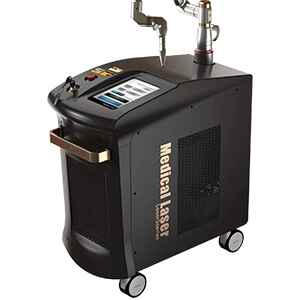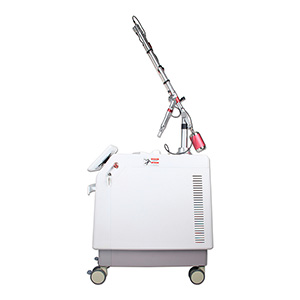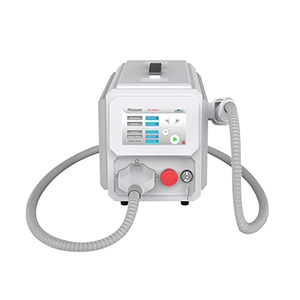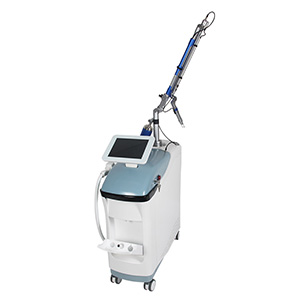Q-Switched Nd: YAG Laser
Q-Switched ND: YAG laser used for tattoo and pigment removal. Leading dermatology, plastic surgery, and laser specialty clinics value Q-switched lasers for their efficacy for a variety of skin issues, primarily unwanted tattoos.
A professional quality-switched laser (Q-Switched) is a non-invasive laser that creates high-intensity pulsed beam light. The Q-Switched laser beam pulses last a mere billionth of a second. The energy emitted from a Q-switched laser is concentrated into very powerful pulses.
Q-switched lasers are able to shatter tiny fragments of pigmentation or ink, stimulate collagen production or kill fungus. Because their contact with the skin is less than other lasers, Q-switched lasers are known for not damaging surrounding tissue and causing unwanted side effects.
With advanced technology, Q-switched lasers are used for many conditions, including the following:
- Tattoo removal
- Treatment of onychomycosis (toenail fungus)
- Age spots
- Sunspots
- Birthmarks
- Freckles
- Moles
- Spider veins
- Café-au-lait spots
- Telangiectasia
- Angiomas
- Port wine stains
- Skin rejuvenation
Types of Q-Switched Lasers
There are several types of Q-switched lasers. The crystal rods inside the lasers differentiate the lasers. The rods allow the Q-switched lasers to produce different wavelengths. These variable wavelengths determine what the Q-Switched laser will be used for.
Some of the Q-Switched lasers include:
- Q-Switched Nd: YAG Laser is used mostly for non-ablative skin rejuvenation, darkened scars, and brown birthmarks. It is recognized for its ability to remove a wide range of tattoo colors.
- Ruby Laser is used to remove rare tattoo colors like lime green and sky blue.
- Alexandrite Laser is used for brown spots, sun spots, darkened scars, brown birthmarks, and melasma, and it has ability to remove black ink tattoos and rare tattoo colors like lime green and sky blue.
While every patient is different, each tattoo that is undergoing removal is different. Different laser wavelengths are required to remove different colors of tattoo ink.
Q-Switched lasers have some pretty significant differences, creating various advantages and disadvantages with each measure.
Active vs. Passive
Actively Q-switched (AQSW) and Passively Q-Switched (PQSW) laser devices are used across the world for their application of tattoo removal, among many other aesthetic procedures. The difference between the two is that actively Q-switched lasers have a more complex pulse production method that allows for greater pulse energy and peak power.
Passively Q-switched lasers are generally less powerful, but more affordable. Technologically speaking, AQSW devices utilize a Pockels Cell to release energy in one single, very powerful pulse, while PQSW devices use a Saturable Absorber which functions similarly but releases energy in a train of pulses. This means that an AQSW device is capable of higher peak power and thus, is more effective at late-stage treatments than a passively Q-switched device.
These lasers are relatively simple to tell apart. AQSW devices are usually large and more than likely have an articulating arm stemming from the top of the system. The AQSW systems are usually comprised of 7 optics, as well as some type of handpiece, allowing for a complete range of motion to treat any location on the body. Professional AQSW systems are not portable as they are sensitive to shock and vibration.
PQSW devices are generally smaller, as well as potentially portable. They come in the form of tabletop units or on-a-cart systems, but always have a gun-shaped treatment head attached with an umbilical cord, as opposed to an articulating arm. This cord contains voltage leads for the flashlamp as well as cooling fluid hoses (deionized water, in most cases). PQSW systems are less vulnerable to shock and vibration, but because the energy is released as a train of pulses, they are not as efficient as tattoo removal devices AQSW systems are.
Picosecond vs Nanosecond
Picosecond devices and AQSW nanosecond devices are much more similar than AQSW are to PQSW devices. One nanosecond is a billionth of a second, and one picosecond is a trillionth of a second. Picosecond systems may be more accurately referred to as sub-nano, quantitatively speaking. Traditional AQSW devices will have a 6-40 nanosecond pulse duration, while picosecond AQSW devices will vary between 500-800 picoseconds – essentially, making the pulse duration 6-10x faster, with equivalent system energy (i.e. .9-1.0 Joules).
The current claim is that picosecond devices can remove tattoos in fewer treatments because the pulse duration is shorter than conventional nanosecond Q-switched lasers. Additionally, the reduction in pulse duration is argued to create less thermal damage, thereby preserving more skin tissue and reducing side effects in the process. The clinical studies performed to research this point have not found picosecond devices to provide a significant statistical difference from the existing nanosecond technology. While a higher peak power is possible with a picosecond device, the point at which this becomes an important aspect in the removal process won’t present itself until potentially after the tattoo has already be removed.
How does the Nd: YAG laser work?
Laser technology has greatly improved the ability to treat melanocytic lesions and tattoos with the rapidly pulsed Q-switched neodymium: yttrium – aluminum – garnet (Nd: YAG) Laser. The laser treatment of pigmented lesions and tattoos is based on the principle of selected photothermolysis. The Q-switched laser systems can successfully lighten or eradicate a variety of benign epidermal and derma-pigmented lesions and tattoos with minimal risk of untoward effects.
Wavelength
532nm wavelength: get rid of freckles, and eyebrow tattoos.
1064nm wavelength: get rid of freckles and yellow-brown spot
1320nm wavelength professional for skin rejuvenation and face-deep cleaning
The Q-Switched Laser Tattoo Removal Process
Laser tattoo removal is the only method proven to remove tattoos without scarring. To remove a tattoo, the Q-Switched laser is pulsed over the tattoo, directing its light energy toward the ink. The energy is absorbed by the ink particles which then shatter into tiny fragments.
In the days following the laser procedure, the body’s immune system will flush away the shattered ink particles and cause the tattoo to fade. With more treatments, more ink will be shattered leaving the skin free of the tattoo.
Only Q-switched lasers are able to produce the amount of energy to remove both dark and bright tattoos without scarring.




